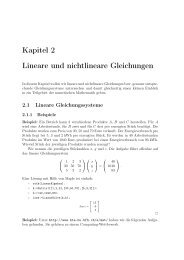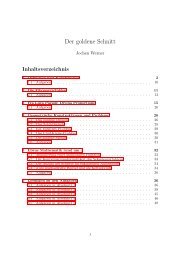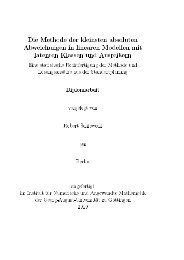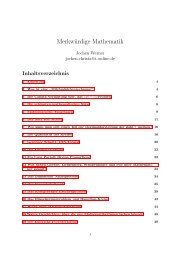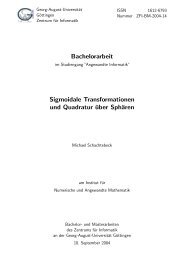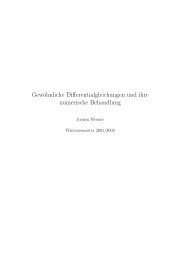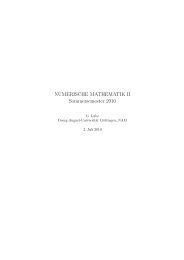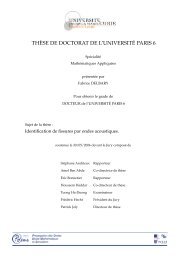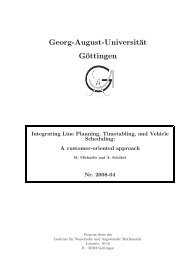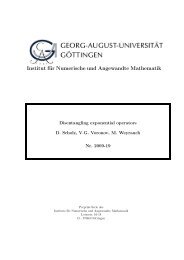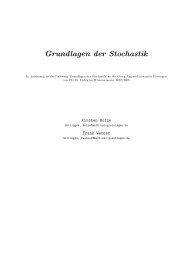BAIL 2006 Book of Abstracts - Institut für Numerische und ...
BAIL 2006 Book of Abstracts - Institut für Numerische und ...
BAIL 2006 Book of Abstracts - Institut für Numerische und ...
You also want an ePaper? Increase the reach of your titles
YUMPU automatically turns print PDFs into web optimized ePapers that Google loves.
M. HAMOUDA, R. TEMAM: Bo<strong>und</strong>ary layers for the Navier-Stokes equations :<br />
asymptotic analysis<br />
✬<br />
✫<br />
We assume that f and u0 are given functions as regular as necessary in the channel<br />
Ω∞, and that U is a given constant; at the price <strong>of</strong> long technicalities, we can also consider<br />
the case where U is nonconstant everywhere.<br />
Theorem 0.1 For each N ≥ 1, there exists C > 0 and for all k ∈ [0, N] an explicit given<br />
function θ k,ε such that :<br />
�v ε N�<br />
− ε k (v k + θ k,ε �L∞ (0,T ;L2 (Ω)) ≤ C ε N+1 , (0.3)<br />
�v ε −<br />
k=0<br />
N�<br />
k=0<br />
ε k (v k + θ k,ε � L 2 (0,T ;H 1 (Ω)) ≤ C ε N+1/2 , (0.4)<br />
where L 2 (Ω) = (L 2 (Ω)) 3 , H 1 (Ω) = (H 1 (Ω)) 3 , and C denotes a constant which depends<br />
on the data (and N) but not on ε. Here v ε denotes the solution <strong>of</strong> the linearized problem<br />
<strong>of</strong> (0.2) and v k the ones <strong>of</strong> the limit problems (ε = 0) at all orders.<br />
The second result concerns the solution <strong>of</strong> the full nonlinear problem (0.2) :<br />
Theorem 0.2 For v ε solution <strong>of</strong> the Navier-Stokes problem (0.2), there exist a time T∗ ><br />
0, correctors function θ 0,ε and θ 1,ε explicitly given, and a constant κ > 0 depending on the<br />
data but not on ε, such that :<br />
�v ε − (v 0 + θ 0,ε ) − ε(v 1 + θ 1,ε )� L ∞ (0,T∗; L 2 (Ω)) ≤ κ ε 2 , (0.5)<br />
�v ε − (v 0 + θ 0,ε ) − ε(v 1 + θ 1,ε )� L 2 (0,T∗; H 1 (Ω)) ≤ κ ε 3/2 . (0.6)<br />
We recall here the limit problem which is the Euler problem and its solution v0 satisfies :<br />
⎧<br />
∂v<br />
⎪⎨<br />
⎪⎩<br />
0<br />
∂t − UD3v 0 + (v 0 .∇) v 0 + ∇p 0 = f, in Ω∞,<br />
div v 0 = 0, in Ω∞,<br />
v 0 3 = 0, on Γ0,<br />
v 0 = 0, on Γh,<br />
v 0 (0.7)<br />
is periodic in the x and y, directions with periods L1, L2.<br />
It is obvious that we can not expect a convergence result between v ε and v 0 (in H 1 (Ω) for<br />
example) and more precisely we are leading with a bo<strong>und</strong>ary layer problem close to some<br />
parts <strong>of</strong> the bo<strong>und</strong>ary Γ. This is the main object <strong>of</strong> our work.<br />
At the following order v 1 is solution <strong>of</strong><br />
⎧<br />
⎪⎨<br />
⎪⎩<br />
∂v 1<br />
∂t − UD3v 1 + (v 1 .∇) v 0 + (v 0 .∇) v 1 + ∇p 1<br />
= − ∂ϕ0<br />
∂t + UD3ϕ 0 − (v 0 .∇) ϕ 0 − (ϕ 0 .∇) v 0 + ∆v 0 , in Ω∞,<br />
div v 1 = 0, in Ω∞,<br />
v 1 3 = 0, on Γ0,<br />
v 1 = 0, on Γh,<br />
v 1 is periodic in the x and y, directions with periods L1, L2.<br />
The function ϕ 0 is a known function at this level.<br />
2<br />
Speaker: HAMOUDA, M. 89 <strong>BAIL</strong> <strong>2006</strong><br />
(0.8)<br />
✩<br />
✪



